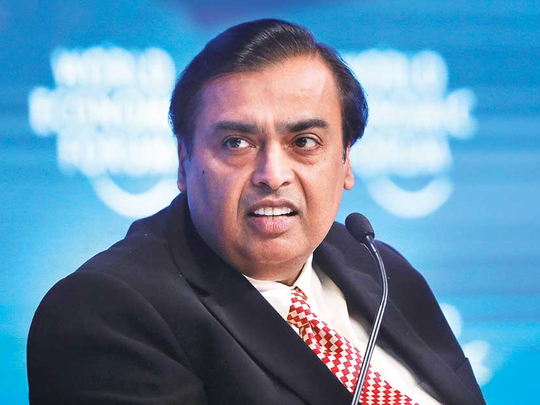
Mumbai: Mukesh Ambani has elbowed past Li Ka-shing to become Asia’s second-richest man as investors rallied behind his efforts to arm India’s poor with cheap data-loaded phones. Some analysts are beginning to focus on the costs of his ambition.
The chairman of Reliance Industries Ltd has added $12.5 billion (Dh45.91 billion) to his wealth this year, according to the Bloomberg Billionaires Index, as shares of his refining-to-telecom company surged to a record. Spurring the rally on is optimism that a new $23 phone launched last month will expand the market for Ambani’s fourth-generation mobile network into India’s hinterland. The whistles and applause that greeted the JioPhone obscured the fact that by one measure the company’s debt has climbed to at least a 15-year high.
The telecom business, Ambani’s seven-year labour of love, has sucked in more than $31 billion in investments and is yet to earn him and his shareholders any profits. It’s contributed to a near tripling of the group’s total debt since March 2012 and sparked a vicious price war in the world’s second-largest mobile-phone market. About 90 per cent of Reliance’s revenues continue to come from its legacy refining and petrochemicals units, with retail, media and energy exploration contributing the rest.
For Ambani, the gains have swelled his net worth to $35.2 billion, taking him to number 19 in the Bloomberg Billionaires Index from 29 at the end of 2016. He passed Li Ka-shing — whose empire spans telecommunications, retail and ports — for a few days in April and again on July 7.
Jio took just nine months after launching with a free introductory offer to rope in 117.3 million users and become India’s fourth-largest operator, according to government data compiled by Bloomberg. Optimism about the telecom upstart’s prospects grew after Ambani announced initial pricing for the service in February, sparking an almost 50 per cent surge in Reliance shares.
The 4G JioPhone fuelled the rally. The handset will run on voice commands in 22 Indian languages and the company expects its cheaper rates and high-speed data access to open up a market of about 500 million customers currently using feature phones on second-generation networks.
Local brokerage Kotak Securities Ltd struck a note of caution on July 23 when it downgraded Reliance’s stock to reduce. “We remain wary of high capex run-rate and rising net debt levels,” wrote Mumbai-based analysts Tarun Lakhotia and Akshay Bhor.
The company’s net debt-to-EBITDA ratio has quadrupled in the five years to March 2017 and is at the highest level since 2002, when Bloomberg began tracking the data. Analysts consider EBITDA a gauge of a company’s operating profit, or the money it makes before paying taxes, interest on loans and accounting for depreciation and amortisation.
A Reliance spokesman didn’t respond to an email seeking comment about the company’s growing debt.
Ambani described Jio as “a jewel” among Reliance assets during the company’s annual general meeting on July 21. “Its business and societal value will grow immensely over the next decade,” he said. “Jio will become India’s largest provider of data service, products and application platforms.”
Since carrier Reliance Jio Infocomm Ltd is a new business, it will have to account for “significant” depreciation and amortisation charges, which will result in losses till the year ending March 2021, Macquarie Research analyst Aditya Suresh wrote in a July 25 report. Depreciation and amortisation allow a company to spread out an asset’s cost over its life.












